ASRock Industrial NUC BOX-1260P and 4X4 BOX-5800U Review: Alder Lake-P and Cezanne UCFF Faceoff
by Ganesh T S on August 5, 2022 8:15 AM EST- Posted in
- Systems
- AMD
- Intel
- UCFF
- Mini-PC
- ASRock Industrial
- Cezanne
- Alder Lake-P
System Performance: UL and BAPCo Benchmarks
Our 2022 test suite for Windows 11-based systems carries over some of the standard benchmarks we have been using over the last several years, including UL's PCMark and BAPCo's SYSmark. Starting this year, we are also including BAPCo's CrossMark multi-platform benchmarking tool.
PCMark 10
UL's PCMark 10 evaluates computing systems for various usage scenarios (generic / essential tasks such as web browsing and starting up applications, productivity tasks such as editing spreadsheets and documents, gaming, and digital content creation). We benchmarked select PCs with the PCMark 10 Extended profile and recorded the scores for various scenarios. These scores are heavily influenced by the CPU and GPU in the system, though the RAM and storage device also play a part. The power plan was set to Balanced for all the PCs while processing the PCMark 10 benchmark.
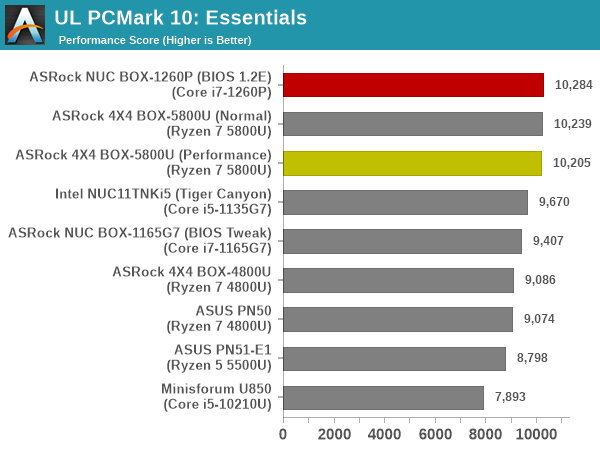
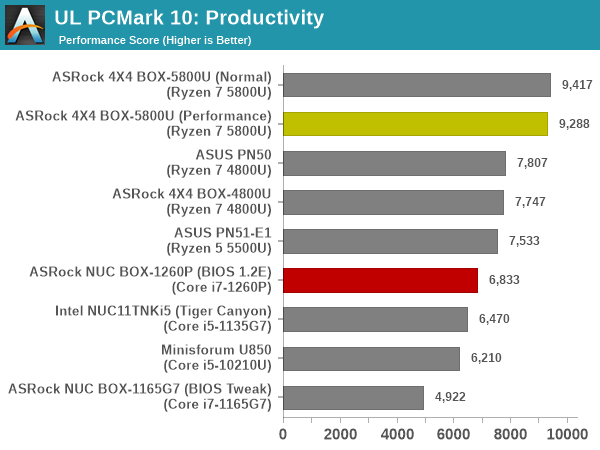
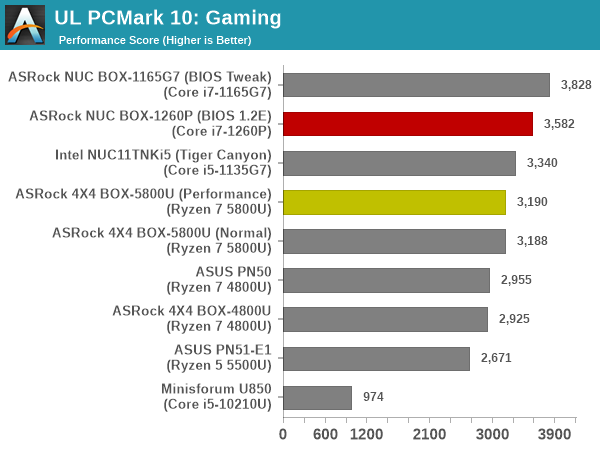
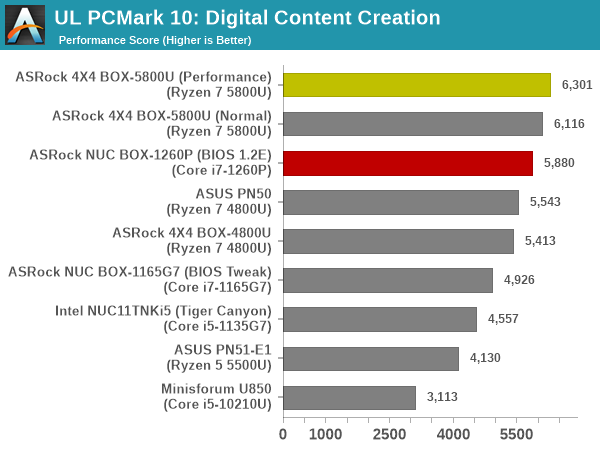
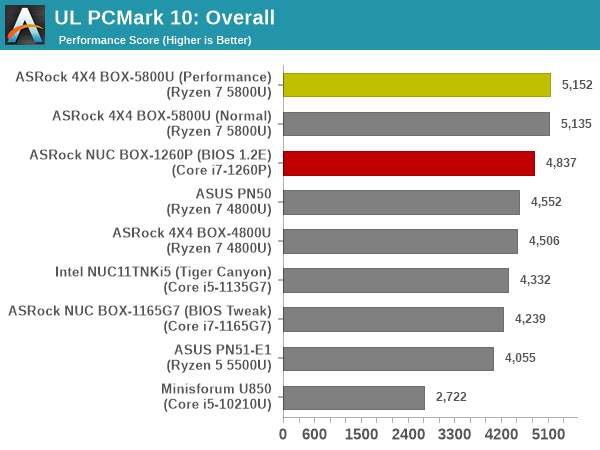
The Essentials and Gaming workloads see the NUC BOX-1260P come out on top with a narrow lead. However, the Productivity and Digital Content Creation workloads both heavily favor multi-threaded processors. The larger number of high-performance cores enable the 4X4 BOX-5800U to gain an healthy edge. Overall, we see the two Cezanne configurations occupy the top two spots in the PCMark 10 leaderboard.
BAPCo SYSmark 25
BAPCo's SYSmark 25 is an application-based benchmark that uses real-world applications to replay usage patterns of business users in the areas of productivity, creativity, and responsiveness. The 'Productivity Scenario' covers office-centric activities including word processing, spreadsheet usage, financial analysis, software development, application installation, file compression, and e-mail management. The 'Creativity Scenario' represents media-centric activities such as digital photo processing, AI and ML for face recognition in photos and videos for the purpose of content creation, etc. The 'Responsiveness Scenario' evaluates the ability of the system to react in a quick manner to user inputs in areas such as application and file launches, web browsing, and multi-tasking.
Scores are meant to be compared against a reference desktop (the SYSmark 25 calibration system, a Lenovo Thinkcenter M720q with a Core i5-8500T and 8GB of DDR4 memory to go with a 256GB M.2 NVMe SSD). The calibration system scores 1000 in each of the scenarios. A score of, say, 2000, would imply that the system under test is twice as fast as the reference system.
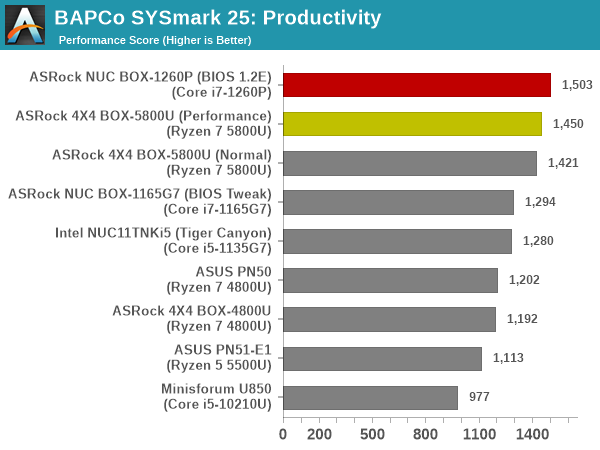
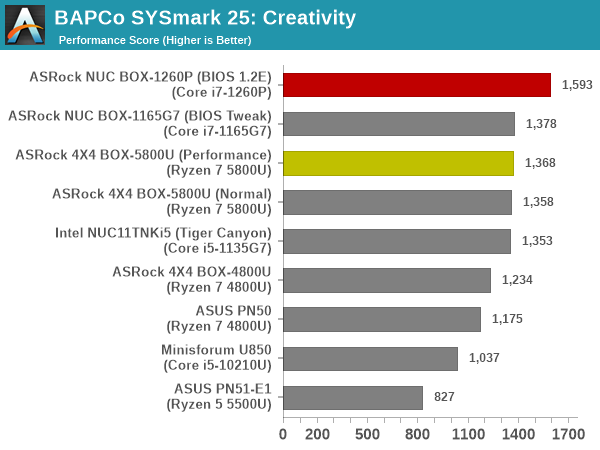
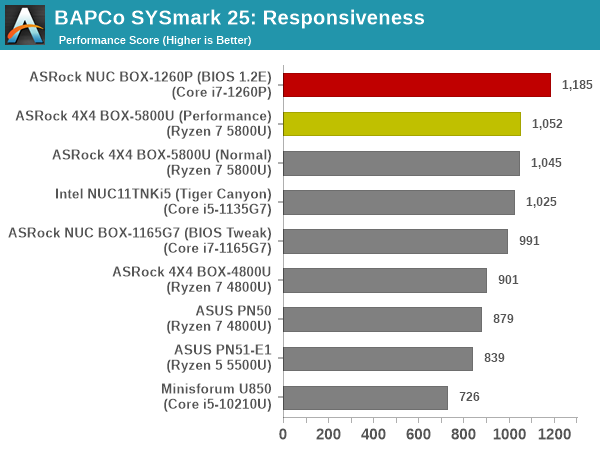
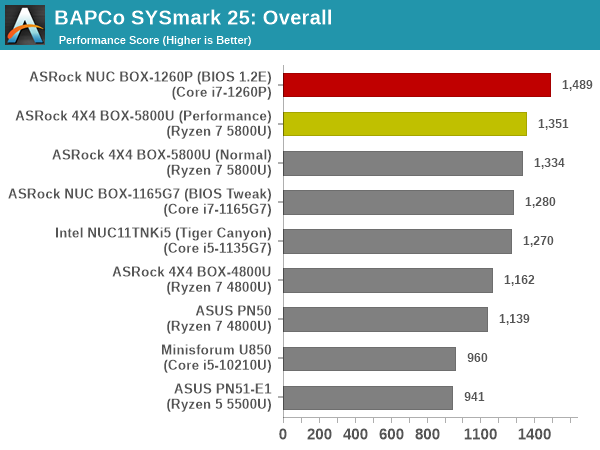
SYSmark 25 also adds energy measurement to the mix. A high score in the SYSmark benchmarks might be nice to have, but potential customers also need to determine the balance between power consumption and the performance of the system. For example, in the average office scenario, it might not be worth purchasing a noisy and power-hungry PC just because it ends up with a 2000 score in the SYSmark 25 benchmarks. In order to provide a balanced perspective, SYSmark 25 also allows vendors and decision makers to track the energy consumption during each workload. In the graphs below, we find the total energy consumed by the PC under test for a single iteration of each SYSmark 25 workload. For reference, the calibration system consumes 8.88 Wh for productivity, 10.81 Wh for creativity, and 19.69 Wh overall.

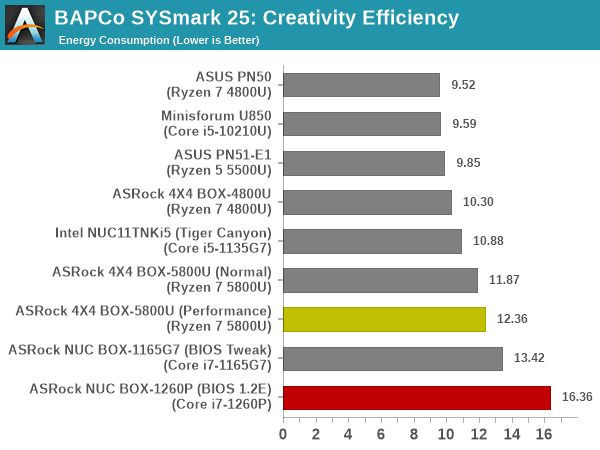
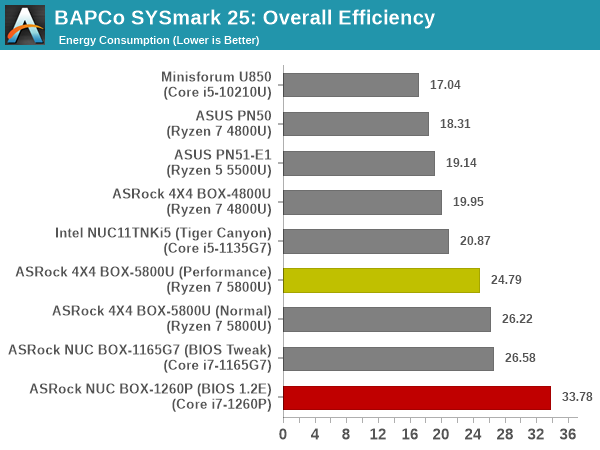
Though the NUC BOX-1260P gets high scores in all segments, the energy consumption is quite high. In fact, at 33.78 Wh overall, it is the worst performer by a significant margin (44.1 / Wh). On the other hand, the Cezanne system in performance mode delivers a score of 54.5 / Wh, and the normal mode delivers a score of 50.9 / Wh. The Cezanne system delivers better performance per Joule in SYSmark 25.
BAPCo CrossMark 1.0.1.86
BAPCo's CrossMark aims to simplify benchmark processing while still delivering scores that roughly tally with SYSmark. The main advantage is the cross-platform nature of the tool - allowing it to be run on smartphones and tablets as well.
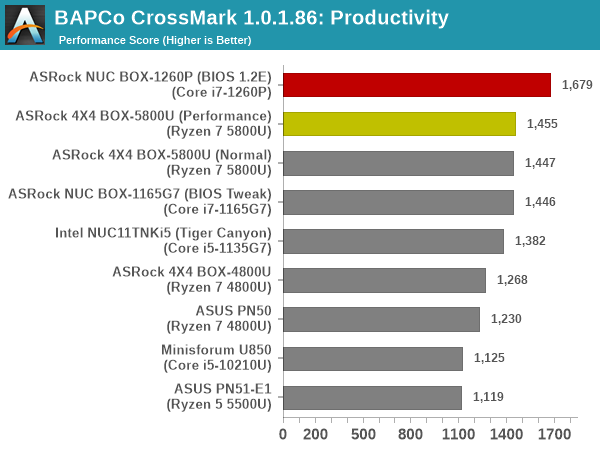
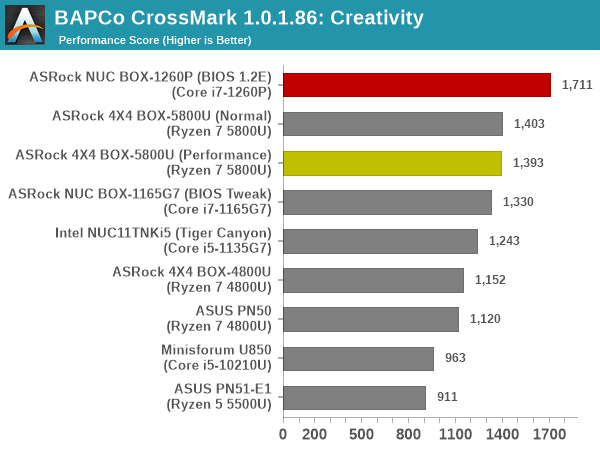
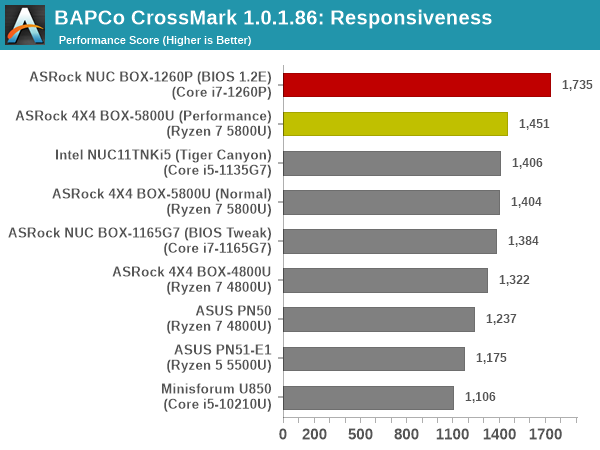
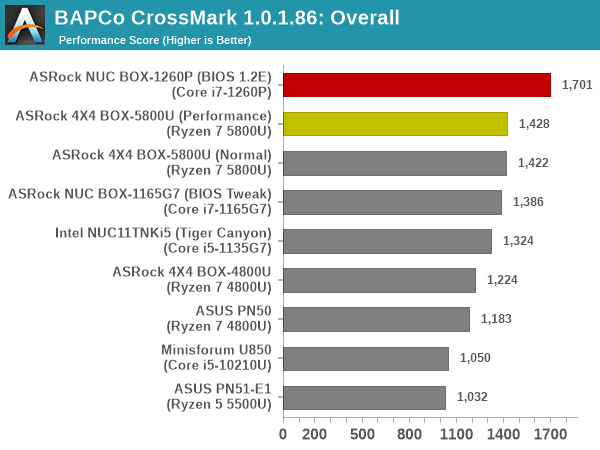
The relative performance seen in SYSmark 25 translate to CrossMark also, as expected. The NUC BOX-1260P comes out on top comfortably, and the Cezanne system is right behind.










34 Comments
View All Comments
AdrianBc - Saturday, August 6, 2022 - link
Regarding the height of the case, there is no need to increase it. Intel has proved, already many years ago, that it is possible to cool without problems even a CPU with PL1 = 45 W, without increasing the volume over the classic high variant of NUC, i.e. with a volume under 0.7 L (as proven by the Skull Canyon NUC, which unfortunately did not have any successor, because Intel replaced it with much larger "NUC" computers intended for gaming).For better cooling in the same case, it would be enough to remove the possibility of installing a 2.5" HDD/SDD, while keeping the same size for the case.
The freed height could be used for a taller cooler, with enough capacity to cool even a 45 W CPU, not only a 28 W CPU.
AdrianBc - Saturday, August 6, 2022 - link
I want to add that even in the coolers of the same height the quality can vary a lot, presumably depending on price.I have a couple of the "8th generation" NUCs, and those had much better coolers than all the older NUCs that I have used, but also, from what I have heard or read, much better than the coolers of newer NUCs, which presumably have reverted to some cheaper coolers.
Those NUC8 coolers, not only are completely silent in normal use, but at maximum load on a Coffee Lake U i7 CPU with PL1 = 30 W and PL2 = 50 W, i.e. with a PL1 default value that is higher than the 28 W nominal value, there is absolutely no thermal throttling regardless how long the computer works at the maximum power consumption of 30 W and the junction temperature never exceeds 90 Celsius degrees.
So a more expensive cooler might also provide an improvement even when it is not taller.
plonk420 - Thursday, August 18, 2022 - link
3dprint one?AdrianBc - Saturday, August 6, 2022 - link
For some reason, the Thunderbolt connector has not been certified yet.Because of that, it cannot be advertised yet.
However, I have seen multiple reports that it works without problems, including in this article.
fishingbait15 - Friday, August 5, 2022 - link
So wish we could get these things running ChromeOS. I wonder if ChromeOS Flex would at least allow the Linux crosvm to run ...PeachNCream - Sunday, August 7, 2022 - link
Thinking that would be good also. What about Android x86 as an alternative? Both should still be well embedded in Alphabet's ecosystem and feature the end user monitoring, data collection, and commercialization recommendations that Google is so good at in terms of how it partners with advertisers to get you relevant, interesting ad content.You could also probably install Linux on bare metal if all you want is vanilla Linux though you aren't going to benefit from having your compute activities observed for better product placement that you would with Google distros of Linux.
iranterres - Friday, August 5, 2022 - link
Nice to see the core i6 in the benchmarks.MrCommunistGen - Friday, August 5, 2022 - link
I'd really love to see HDMI 2.1 ports on these machines since both AMD and Intel platforms should theoretically be able to support the newer standard from their iGPUs.If either supported HDMI 2.1 I'd consider using one as a multimedia box hooked up to a TV.
nandnandnand - Friday, August 5, 2022 - link
https://www.cnx-software.com/2022/01/05/intel-alde...https://www.theverge.com/2022/1/4/22855915/intel-1...
Intel only integrated HDMI 2.0b support. I guess another chip has to be added to get HDMI 2.1, like in this:
https://www.tweaktown.com/news/85259/gigabyte-brix...
Rembrandt supports HDMI 2.1, as will the iGPU in Raphael. Raptor Lake will add it according to this leaked slide:
https://www.notebookcheck.net/Intel-Raptor-Lake-S-...
So it will become more common to see HDMI 2.1 support in 2023-2024. DisplayPort 2.0 as well.
Igor_Kavinski - Saturday, August 6, 2022 - link
Excellent review, Ganesh! Really enjoyed seeing the battle between these two CPUs. Some of the wins for the Intel Alder Lake were surprising, like the iGPU and in some benchmarks like 7-zip, 5800U is a monster! Hope to see more "reviews done right" from you soon!